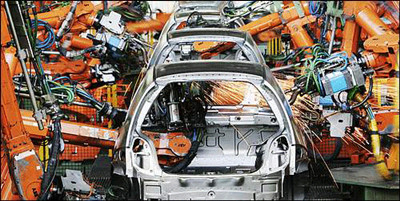中土王國汽車制造商
Zoom, zoom, splutter
一朝得志,語無倫次
SAIC's domestic brands are unloved—a problem shared across the industry
上汽集團的國內品牌不受消費者歡迎,然而,這卻是整個產業所遇到的問題
CHINA'S biggest carmaker does not seem to be doing so badly, a first glance at SAIC's third quarter results on October 30th would suggest. Net profits rose by nearly 5% compared with a year earlier, to 6.8 billion yuan ($1.1 billion). But SAIC, like the country's many other domestic car firms, is not firing on all cylinders and is far from living up to the hopes the government has invested in the state giant.
上汽集團在10月30日發布了本年第三季度報,乍一看之下,這家全中土王國最大汽車制造商的成績似乎還過得去:與去年同期相比,凈利潤增長約5%,達到了68億元人民幣(約11億美元)。然而,就像中土王國國內其余眾多廠商一樣,上汽集團不僅沒有開足馬力進行生產,同時也辜負了政府對這家汽車業國營巨頭的期待。

SAIC makes a quarter of the vehicles that crawl along the country's congested roads. In the third quarter it sold 1.3m cars, 9% more than a year earlier. Overall Chinese demand, tempered by a cooling economy, grew by just 4%. But SAIC's success was mostly due not to cars bearing its own badges, but Volkswagen and General Motors models, made in factories jointly operated with these two Western giants.
目前,在中土王國擁擠不堪的道路上,有四分之一的轎車是上汽集團生產的。在本年第三季度期間,該企業共賣出了1300萬輛轎車,比去年同期高出了9%。而相比之下,由于受到了經濟下行的影響,今年中土王國汽車總需求量僅增長了4%。但上汽集團斐然的成果,不是由自家品牌所貢獻出來的,而是通過與德國大眾(Volkswagen)以及美國通用汽車(General Motors)這兩大西方巨頭的聯合,在合資企業里所推出的車型當中取得的。
Foreign carmakers were forced to collaborate with Chinese ones as the price for entering what is now the world's largest automotive market. SAIC's partnerships with VW and GM are flourishing, as are the other Chinese-foreign joint ventures. The government had hoped that, by now, domestic firms would have absorbed all they needed to know from the foreigners about making and selling world-class cars, and be ready to get by without them.
要進入中土王國這個目前全球最大的汽車銷售市場,得付出一定的準入代價:外國汽車制造商必須要與本土廠商成立合資企業來進行生產銷售。不僅是上汽集團正與大眾、通用合作無間,其他中外合資車廠也呈現出欣欣向榮的態勢。中土王國政府本期待著現在國內制造商們已經學習吸收了一切必備的外來經驗技術,并且已經做好了自力更生的準備以生產“世界級”轎車,但事情不盡如人意。
But the success of the joint ventures has made the Chinese firms complacent. They have failed to develop their own technology, styling or marketing capability. SAIC has long been losing money on its own-brand cars, which sell under badges such as Roewe and MG (the latter a faded British brand it bought along with other parts of the collapsed Rover Group). In the latest quarter the losses rose sharply, to around 2 billion yuan. A vicious circle has set in: the poor financial performance of Chinese firms' own brands has sapped their will to invest in research and development to improve their performance on the road and in the showrooms. Little wonder, then, that Chinese motorists spurn pleas for patriotism and covet foreign-badged motors.
然而,合資企業的成功已經讓中土王國制造商們欣喜不已。他們沒有成功地發展出自己的生產技術、設計風格以及市場推廣體系。在自有品牌的車型上,上汽集團已經損失了很多資金,其中包括“榮威”(Roewe)和“名爵”(MG,一個已經沒落了的英國品牌),后者是上汽集團在“路虎”(Rover Group)破產之時一并買入的汽車牌子之一。在最近一季期間,上述部分的虧損額迅猛增加,達到了20億元人民幣。這是一個惡性循環:國產品牌的表現越差,中土王國制造商就越不愿意投入資金以提高技術研發能力,或者提高國產車無論是在行駛中還是在汽車展廳當中的表現。這也就能解釋了,為何中土王國司機們會唾棄在駕駛上的展現愛國主義情懷的機會,反倒是極力推崇外國品牌的轎車。
The government has tried to fix the problem by pressing the foreign carmakers to work with the locals to create new brands combining international flair with Chinese characteristics. So far this has made little difference: Chinese brands account for only about one-third of domestic sales, and their share continues to dwindle.
中土王國政府想要通過強迫外國制造商與本土企業的合作來解決上述問題,希望能夠創造出一批新的品牌,一批能夠把國際上的優點與中土王國特色相結合的品牌。迄今為止,以上努力近乎徒勞,國產牌子的汽車僅占中土王國國內汽車銷售的三分之一,而且該市場份額還在縮小。
Chinese vehicles have not travelled well. Exports, mostly to poor countries where drivers care about price more than image, were fewer than 600,000 in 2013, 10% lower than the year before. SAIC's hopes that Rover Group's brands and technology would help it do better in rich countries have yet to be met. Three years after it relaunched the MG brand in Britain, it is selling just a few hundred cars a month there. Likewise Geely, a smaller Chinese maker, has yet to see much benefit from buying Volvo of Sweden.
中土王國汽車的發展目前仍是處于“菜鳥”階段。2013年全年汽車出口量已經不足60萬,與前年同期相比下降了10%,而出口的汽車大部分是運往貧困國家。相比于外觀而言,當地的消費者更在意的是價格。上汽集團希望能通過“路虎”旗下的品牌和技術,來提升自己在發達國家的市場地位,而這一想法還有待實現。三年前,上汽集團在英國重新推出了“名爵”汽車,而現在該牌子的銷量也僅僅為每月數百輛而已。同樣地,較小的中土王國汽車制造商“吉利”汽車,仍未從瑞典沃爾沃(Volvo)汽車收購案當中獲得可觀的回報。
China's carmakers are still trying to improve. A recent survey from JD Power, a market-research firm, shows that the quality gap with foreign rivals is closing. The Chinese firms are busy hiring Western designers to make their models more distinguished. But like many of its peers, SAIC lacks foreign managers who have the skills to market cars abroad and set up the service networks that buyers expect. No wonder the government's ambition for China to boast two or three world-class car firms, with badges as recognisable as Toyotas or Fords, remains a distant dream.
中土王國汽車制造商仍舊在努力提升自己。最近,一份由市場分析機構JD Power所做的調查顯示,中土王國國產品牌汽車與外國對手的質量差距正在逐漸縮小。中土王國廠商們正忙著聘請西方設計師去完成車型的設計,力求“與眾不同”。但就像其他許多同行一樣,上汽集團缺乏來自國外的管理者,一些能夠讓汽車進行市場推廣走出國門,并且能夠建立滿足于消費者期待的服務網絡的管理者。中土王國政府想要培養出兩三個能夠生產“殿堂級”汽車的制造商,想要培養出能夠跟豐田(Toyota)和福特(Ford)一樣家喻戶曉的廠商,在如此多的不利因素的作用之下,也難怪這些個“雄心壯志”最后只成了一個“中國夢”。譯者:顏士竣












